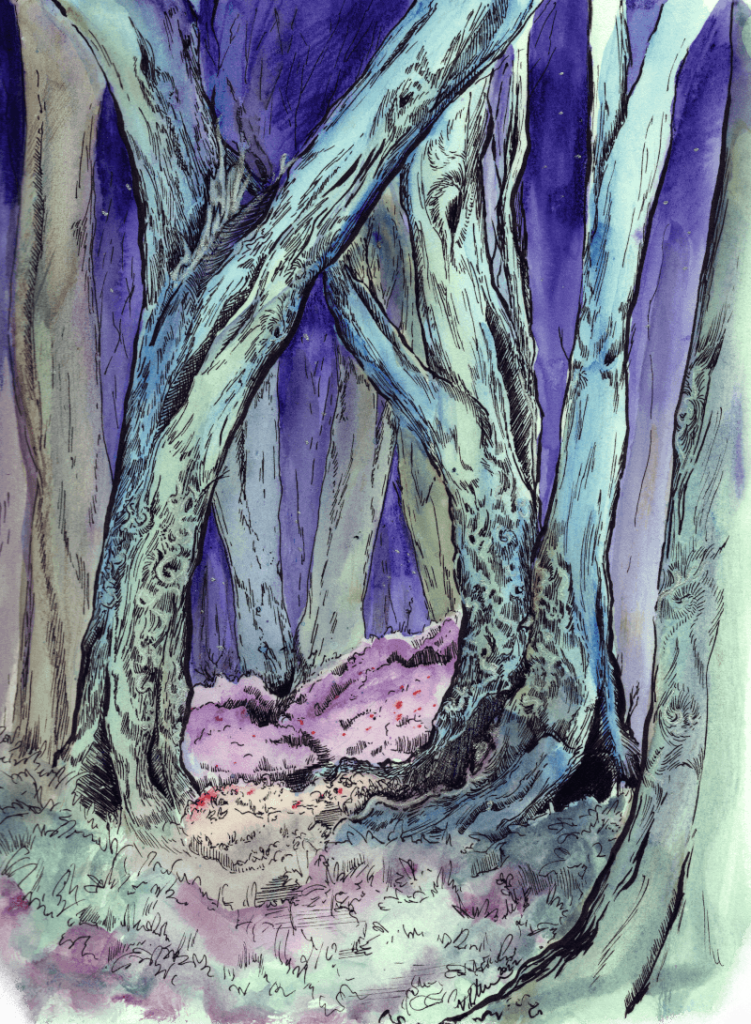
I have a strange obsession with detailing various trees and other vegetation in my Dungeons & Dragons campaign.
This post introduces a new tree I needed to create for a particular adventure for my solo D&D campaign.
The Cave Oak
The Cave Oak is a tree that thrives near cave entrances and in hilly regions, and has developed unique traits to adapt to that environment. These are outlined below.

Root Structure
Extensive & Flexible Roots
To anchor itself securely in rocky, uneven terrain, the Cave Oak has develop deep, sprawling roots capable of penetrating cracks in rocks. These roots can also extend far underground to seek water sources in the caves beneath.
Sometimes dungeon explorers will see exposed roots in caverns from these trees.
Symbiotic Relationship
The roots can form a symbiosis with fungi common in cave ecosystems, allowing it to absorb additional nutrients that regular surface trees cannot access.
Canopy & Leaves
The Cave Oak has broad, dark green leaves to catch the maximum sunlight as it grows in semi-shaded spots near hills and cave entrances.
Bark and Trunk
Thick, Rugged Bark
The bark of the Cave Oak is particularly tough and gnarled to protect it from the wind and cold air coming from caves. This bark is also be resistant to moss or lichen growth that tends to flourish in damp environments.
Stone-Like Texture
As the tree gets older, it develops a bark pattern resembling the surrounding rock formations, blending in with the hillsides.
Acorns
Hardier Acorns
Acorns of the Cave Oak have tougher shells than regular acorns to withstand rocky falls and harsher environments.
Slower Germination
To account for unpredictable conditions near cave entrances (such as shifts in temperature or moisture levels), the acorns have a delayed germination cycle, waiting for ideal conditions to sprout.
Wood and Growth
Sturdy, Dense Wood
The wood of the Cave Oak is exceptionally dense, ideal for furniture, tools, or construction. Its slow growth in rocky areas could contribute to a finer grain, making it highly valued for crafting.
Curved Growth Patterns
In hilly regions, the trunk might grow at unusual angles, bending or twisting to find sunlight in challenging terrain. This could give the tree a unique appearance.
Wildlife Interactions
Shelter
The roots of the Cave Oak create small sheltered spaces around cave entrances, offering habitat for animals that live between the cave and the surface, such as bats or small mammals.
Specialized Fauna
Creatures that typically inhabit caves tend to interact with the tree, aiding in seed dispersal, such as cave-dwelling bats and burrowing animals.
This unique oak plays an important ecological role in hilly regions near caves, serving as a bridge between underground ecosystems and surface environments.
Resources
The Cave Oak offers a variety of valuable resources to those who utilize it. Below is a more detailed look at the resources it might provide.
Wood
Due to the slow growth and harsh conditions of its environment, Cave Oak wood is exceptionally strong, dense, and durable.
Construction: Ideal for building in rugged terrain, the wood’s toughness makes it excellent for structures like homes, bridges, or fortifications, especially in hilly or mountainous regions.
Furniture: Fine-grained and strong, the wood is perfect for crafting long-lasting, high-quality furniture and tools, particularly items that need to withstand rough use.
Game Effect: If you are using the improvised weapons rules from Issue 16 of d12 Monthly, then treat furniture made cave oak wood once size category larger than it is for damage inflicted.
Weapons and Tools: The dense wood is used for making durable handles for weapons (like axes and hammers), and tools (such as shovels, picks, or hammers). Its strength rivals other types of oak or hardwood.
Game Effect: Wooden weapons, such as clubs, staves, and axe handles, gain a better resistance against being damaged. This can equate to a +2 bonus to saving throws, or, if you are using the weapons rules from Issue 3 of d12 Monthly, then it ignores the first damage die reduction it sustains.
Woodcraft and Art: The unusual twisting and curved growth of the tree in rocky terrain yields interesting shapes and patterns, making it desirable for artistic woodcraft, statues, or ceremonial items.
Game Effect: These are worth an additional 10% when selling a decorative item made from cave oak.
Acorns
Like regular oak acorns, the Cave Oak’s acorns can be used as a source of food, but are hardier and richer in nutrients due to the tree’s adaptations (see above).
Flour and Porridge: The acorns can be processed into flour for baking, or used to make a nourishing porridge – serving as a reliable food source in hilly or less fertile regions where traditional crops struggle to grow.
Game Effect: This can be a replacement for wheat or barely in rockier terrain if enough trees are harvested.
Preserved Acorns: Due to their tough shells, these acorns are better suited for long-term storage, making them a valuable survival food, especially for mountain-dwelling peoples or those in remote regions.
Game Effect: The acorns from a cave oak last twice as long as regular oak acorns.
Bark
The Cave Oak’s thick, resilient bark contains unique properties that can be used in traditional medicine.
Game Effect: Druids can use the bark, after processing, for natural armour. This give the wearer an AC of 6 [13] in OSE.
Anti-inflammatory teas or salves: The bark can be boiled or processed into medicinal teas or balms to treat inflammation, muscle pain, or wounds.
Game Effect: If used for treating wounds, the injured receive an additional +1 to HP, or it can lower rest rates by 1 day (depending on what rules you are using).
Fungal Resistance: The bark is naturally resistant to fungus due to its environment, and contain antifungal compounds that can be extracted and used to treat skin conditions or preserve food.
Game Effect: If treating a fungal wound, then the healer gains a +2 bonus to any healing rolls that need to be made.
Game Effect: If used as a preservative, any food will last 50% longer when using cave oak bark.
Durable Materials
The bark can also be used in practical applications.
Leatherworking and Tanning: Like other oaks, the Cave Oak have tannins in its bark, which can be used to tan hides and produce durable leather.
Shelter and Insulation: Large pieces of bark can be used as natural roofing or insulation in makeshift shelters, offering protection against wind, rain, and cold in the hilly regions.
Roots
The roots of the Cave Oak, especially with their possible symbiosis with fungi, can be used for medicinal purposes.
Herbal Remedies: Roots can be processed into medicinal extracts or teas, especially for treating fatigue or ailments related to damp environments.
Game Effect: If treating fatigue, the tea from cave oak roots halves the healing time to heal any fatigue.
Structural Uses
The extensive root network could also have practical uses.
Rope or Twine: Some of the thinner, flexible roots can be dried and used as natural rope or twine, offering a resource for crafting or construction.
Game Effect: This is equivalent to silk rope.
Sap and Resins
The sap or resin of the Cave Oak can be a natural source of waterproofing materials. Those trees that grows in damp, cave-like environments, have sap that has developed protective, water-resistant properties.
Game Effect: If used to wrap bows and bow strings, you can ignore any wetness or dampness rules that apply to these (bow strings are next to useless when they get wet).
Sealant: It can be used to coat wooden tools, weapons, or boats to protect them from moisture damage.
Glue: The sticky resin can serve as a natural adhesive, useful in woodworking or other crafts.
Cultural and Religious Significance
Sacred Trees
Given their proximity to caves, which often carry spiritual or mystical significance in many cultures, Cave Oaks are, in some places, considered sacred.
They can be used in religious rituals, or their wood can be reserved for crafting items of religious or cultural importance, such as idols, totems, or ceremonial tools.
Protection of Cave Entrances
The presence of Cave Oaks near cave entrances can lead to beliefs that the trees protect or guard the caves, leading people to plant or cultivate them near important underground sanctuaries, mines, or treasure hoards.
The tree sometimes symbolically represent the boundary between the surface world and the mysteries of the underground.
Concluding
From its dense, durable wood to its medicinal properties and even its symbiotic relationship with underground fungi, the cave oak can provide a wealth of resources for those who live nearby.
Over To You
Do you obsess over anything is your own campaigns? Can you see uses for this tree is your world?
While You’re Here…
Since 2021 I have been publishing d12 Monthly, a monthly zine, which has a ton of articles for any edition of Dungeons and Dragons.
Printed copies are available in my store. The PDF is available on DriveThruRPG and you can get both, plus support my work, via my Patreon.
I will also be releasing some more products in the near future.
Feel free to reach out to me on Twitter or my contact page any time.

We need more stuff like this, A Nature handbook, shall we say?
I am actually slowly working one, but it is a slow burn currently.